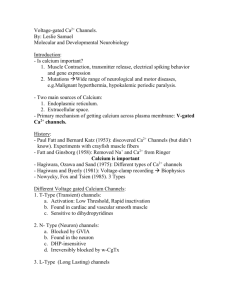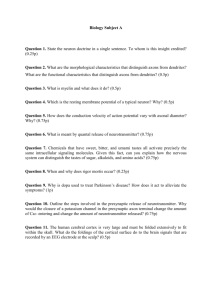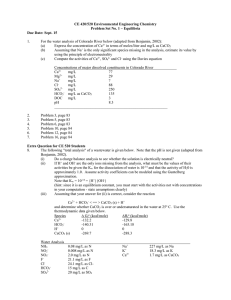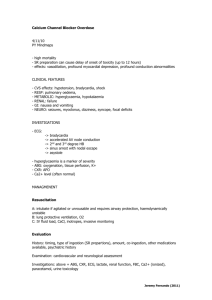Effect of buffers on calcium signalling in presynaptic boutons
advertisement
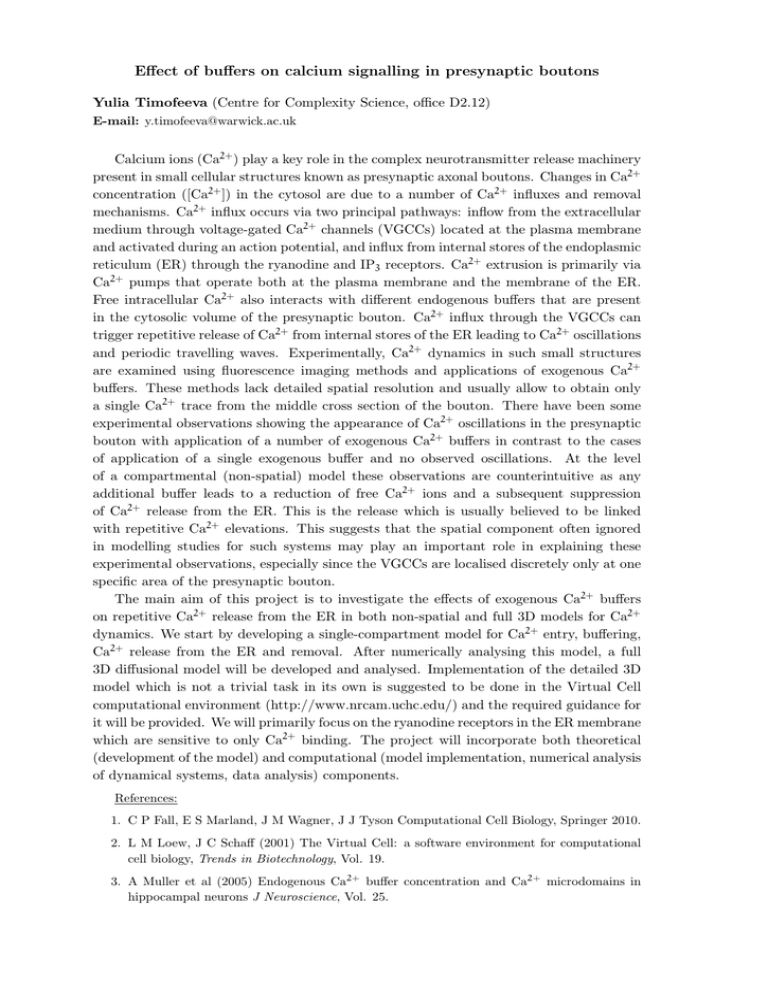
Effect of buffers on calcium signalling in presynaptic boutons Yulia Timofeeva (Centre for Complexity Science, office D2.12) E-mail: y.timofeeva@warwick.ac.uk Calcium ions (Ca2+ ) play a key role in the complex neurotransmitter release machinery present in small cellular structures known as presynaptic axonal boutons. Changes in Ca2+ concentration ([Ca2+ ]) in the cytosol are due to a number of Ca2+ influxes and removal mechanisms. Ca2+ influx occurs via two principal pathways: inflow from the extracellular medium through voltage-gated Ca2+ channels (VGCCs) located at the plasma membrane and activated during an action potential, and influx from internal stores of the endoplasmic reticulum (ER) through the ryanodine and IP3 receptors. Ca2+ extrusion is primarily via Ca2+ pumps that operate both at the plasma membrane and the membrane of the ER. Free intracellular Ca2+ also interacts with different endogenous buffers that are present in the cytosolic volume of the presynaptic bouton. Ca2+ influx through the VGCCs can trigger repetitive release of Ca2+ from internal stores of the ER leading to Ca2+ oscillations and periodic travelling waves. Experimentally, Ca2+ dynamics in such small structures are examined using fluorescence imaging methods and applications of exogenous Ca2+ buffers. These methods lack detailed spatial resolution and usually allow to obtain only a single Ca2+ trace from the middle cross section of the bouton. There have been some experimental observations showing the appearance of Ca2+ oscillations in the presynaptic bouton with application of a number of exogenous Ca2+ buffers in contrast to the cases of application of a single exogenous buffer and no observed oscillations. At the level of a compartmental (non-spatial) model these observations are counterintuitive as any additional buffer leads to a reduction of free Ca2+ ions and a subsequent suppression of Ca2+ release from the ER. This is the release which is usually believed to be linked with repetitive Ca2+ elevations. This suggests that the spatial component often ignored in modelling studies for such systems may play an important role in explaining these experimental observations, especially since the VGCCs are localised discretely only at one specific area of the presynaptic bouton. The main aim of this project is to investigate the effects of exogenous Ca2+ buffers on repetitive Ca2+ release from the ER in both non-spatial and full 3D models for Ca2+ dynamics. We start by developing a single-compartment model for Ca2+ entry, buffering, Ca2+ release from the ER and removal. After numerically analysing this model, a full 3D diffusional model will be developed and analysed. Implementation of the detailed 3D model which is not a trivial task in its own is suggested to be done in the Virtual Cell computational environment (http://www.nrcam.uchc.edu/) and the required guidance for it will be provided. We will primarily focus on the ryanodine receptors in the ER membrane which are sensitive to only Ca2+ binding. The project will incorporate both theoretical (development of the model) and computational (model implementation, numerical analysis of dynamical systems, data analysis) components. References: 1. C P Fall, E S Marland, J M Wagner, J J Tyson Computational Cell Biology, Springer 2010. 2. L M Loew, J C Schaff (2001) The Virtual Cell: a software environment for computational cell biology, Trends in Biotechnology, Vol. 19. 3. A Muller et al (2005) Endogenous Ca2+ buffer concentration and Ca2+ microdomains in hippocampal neurons J Neuroscience, Vol. 25.

